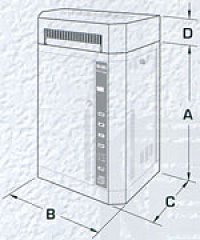Dimensions
| Model | A | B | C | D+A | SDU |
| SK302 | 597mm 23-1/2" |
470mm 18-1/2" |
292mm 11-1/2" |
737mm 29" |
SDU-1 |
| SK304 | 597mm 23-1/2" |
470mm 18-1/2" |
292mm 11-1/2" |
737mm 29" |
SDU-1 |
| SK306 | 597mm 23-1/2" |
470mm 18-1/2" |
292mm 11-1/2" |
737mm 29" |
SDU-1 |
| SK309 | 597mm 23-1/2" |
470mm 18-1/2" |
292mm 11-1/2" |
737mm 29" |
SDU-1 |
| SK311 | 597mm 23-1/2" |
470mm 18-1/2" |
292mm 11-1/2" |
737mm 29" |
SDU-1 |
| SK314 | 724mm 28-1/2" |
533mm 21-1/2" |
318mm 12-1/2" |
890mm 35" |
SDU-2 |
| SK320 | 724mm 28-1/2" |
533mm 21-1/2" |
318mm 12-1/2" |
1048mm 41-1/4" |
SDU-3 |
| SK330 | 724mm 28-1/2" |
533mm 21-1/2" |
318mm 12-1/2" |
1048mm 41-1/4" |
SDU-3 |
| SK340 | 794mm 31-1/4" |
813mm 32" |
318mm 12-1/2" |
- | - |
| SK360 | 794mm 31-1/4" |
813mm 32" |
318mm 12-1/2" |
- | - |
SK300 SDU (SPACE DISTRIBUTION UNIT)
available on models SK302 to SK330
